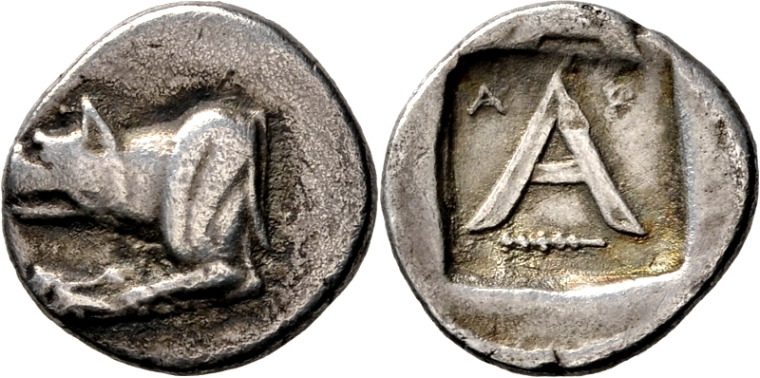330 BCE - 270 BCE | Φ - Α
Overstriking coin
Phalasarna_Künker_mars_2008_311_(sur_Argos).jpg
[1]
Overstruck variety
Argos (under Phalasarna).jpg
[2]
|
|
Sale(s)Sale(s) ᵖ:
|
Hirsch Nachf., 178, 1993, 253 = Künker, 136, 10 March 2008, 311
|
|
|
|
Description
| ObverseInscription or printing placed on the obverse.:
|
Head of Artemis Diktynna right, wearing single-pendant earring and necklace
|
ReverseInscription or printing placed on the reverse.:
|
Φ - Α (Greek) Ornate trident head. Border of dots.
|
Mint and issuing power
| MintIdentifies the place of manufacture or issue of a numismatic object.:
|
Phalasarna
|
Ancient regionAncient region.
|
Crete
|
Modern countryModern country: Crete
|
AuthorityIdentifies the issuing power. The authority can be "pretended" when the name or the portrait of X is on the coin but he/she was not the issuing power. It can also be "uncertain" when there is no mention of X on the coin but he/she was the issuing power according to the historical sources:
|
|
Chronology
| FromIdentifies the initial date in a range assigned in a numismatic context. 330 BCE toIdentifies the final date in a range assigned in a numismatic context.. 270 BCE
|
Hellenistic 323-30 BC  periodTime period of the numismatic object. periodTime period of the numismatic object.
|
Physical description
MetalThe physical material (usually metal) from which an object is made.: Silver 
|
WeightWeight of the numismatic object (in grams). in grams: 2.542.54 g <br />2,540 mg <br />
|
DenominationTerm indicating the value of a numismatic object. Examples: tetradrachm, chalkous, denarius.: hemidrachm 
|
|
|
|
StandardStandard.: Aeginetic
|
References
Description
| ObverseInscription or printing placed on the obverse.:
|
Forepart of wolf
|
ReverseInscription or printing placed on the reverse.:
|
A within shallow incuse square
|
Mint and issuing power
| MintIdentifies the place of manufacture or issue of a numismatic object. ᵖ:
|
Argos
|
Ancient regionAncient region. ᵖ
|
Peloponnesus
|
Modern countryModern country: Greece
|
AuthorityIdentifies the authority in whose name (explicitly or implicitly) a numismatic object was issued. ᵖ:
|
|
Chronology
| FromIdentifies the initial date in a range assigned in a numismatic context. 320 BCE toIdentifies the final date in a range assigned in a numismatic context.. 280 BCE
|
Hellenistic 323-30 BC  periodTime period of the numismatic object. periodTime period of the numismatic object.
|
Physical description
| DenominationTerm indicating the value of a numismatic object. Examples: tetradrachm, chalkous, denarius. ᵖ:
|
hemidrachm 
|
StandardStandard. ᵖ:
|
Aeginetic
|
References
References
- ^ Svoronos, Ioannes N. (1890), Numismatique de Crète ancienne, accompagnée de l'histoire, la géographie et la mythologie de l'île. Première partie, description des monnaies, 2 vol., Macon, Impr. Protat frères.
- ^ Le Rider, Georges (1966), Monnaies crétoises du Ve au Ier siècle av. J.-C., Paris, Geuthner, 345 p. and 42 pl.
- ^ Hoover, Oliver D. (2011), Handbook of Greek Coins 5. Coins of the Peloponnesos, Achaia, Phleiasia, Sikyonia, Elis, Triphylia, Messenia, Lakonia, Argolis, and Arkadia, Sixth to First Centuries BC, Lancaster (PA), 2011.

